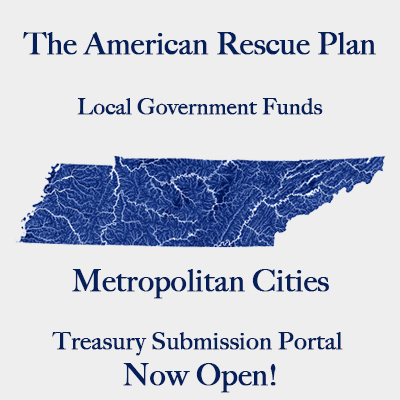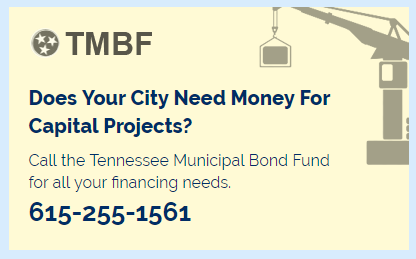
Treasury Submission Portal
METROPOLITAN CITIES ENTITLED TO RECEIVE FUNDS DIRECTLY FROM THE U.S TREASURY
- Metropolitan cities include those municipalities with populations greater than 50,000 and cities that are designated principal cities of Metropolitan Statistical Areas.
How much money will metropolitan cities receive?
- The current total allocation estimate for Tennessee’s metropolitan cities is approximately $517,000,000.00. You may view your city’s share HERE
When will funds from the American Rescue Plan be received?
- For metropolitan cities, the U.S. Treasury will disburse 50% of allocated funds directly upon completion of the verification process which takes 4 business days upon receiving application
- The second half of a city’s allocation will be distributed one year following receipt of the first half.
- From Interim Final Rule: Payments in Tranches to Local Governments
What steps need to be taken in order to receive the funds?
- Metropolitan cities must have a valid DUNS number to meet reporting requirements under the program.
- A DUNS number is a unique nine-character number used to identify an organization and is issued by Dun & Bradstreet. The federal government uses the DUNS number to track how federal money is allocated. A DUNS number is required prior to registering with the SAM database, which is outlined below. Registering for a DUNS number is free of charge.
- If your municipality does not have a valid DUNS number, please visit this page or call 1-866-705-5711 to begin the registration process.
- Ensure your municipality has an active SAM registration - SAM is the official government-wide database to register with in order to do business with the U.S. government. All Federal financial assistance recipients must register on SAM.gov and renew their SAM registration annually to maintain an active status to be eligible to receive Federal financial assistance. There is no charge to register or maintain your entity SAM registration.
- If your municipality does not have an active SAM registration, please visit, SAM.gov to begin the entity registration or renewal process. Please note that SAM registration can take up to three weeks; delay in registering in SAM could impact timely payment of funds.
- It is also recommended that entitlement units have the following information ready in order to receive funds from the state:
- Entity Identification Number (EIN), name, and contact information;
- Name and title of an authorized representative of the entity; and
- Financial institution information (e.g., routing and account number, financial institution name and contact information).
Additional information for Metropolitan Cities to apply. This is from NLC and includes a link to the portal. Please check against existing information on this page and supplement as required.
Accessing the Treasury Department Portal to Request Funding
The portal for local governments that will receive their money directly from the Treasury is live. The link can be found here.
This link is for cities classified as Metropolitan Cities under the American Rescue Plan Act (ARPA).
Local governments designated as non-entitlement units are eligible to receive Coronavirus State and Local Fiscal Recovery Funds, as provided in the American Rescue Plan Act. However, they will receive this funding from their applicable state government, not though this link.
SUBMISSION REQUIREMENTS
To complete a submission on behalf of your jurisdiction, you will be asked to provide the following information:
- Jurisdiction name, taxpayer ID number, DUNS Number, and address
- Authorized representative name, title, and email
- Contact person name, title, phone, and email
- Funds transfer information, including recipient's financial institution, address, phone, and routing number and account number
- Completed certification document (to be signed by the authorized representative)
Jurisdictions must submit a request to receive funding even if they have previously applied for other programs through the Treasury Submission Portal. Eligible jurisdictions will receive further communications regarding the status of their submission via the email address provided in the Treasury Submission Portal.
Are there any restrictions on uses of the funds?
- Uses of federal funds that are expressly prohibited:
- Directly or indirectly offsetting a tax cut
- Pension funds
- From Interim Final Rule: Restrictions on Use
How long is the time frame to spend the funds?
- Funds for local governments will “remain available through December 31, 2024.” Treasury will need to decide whether this means spent by or obligated by that date.
- From Interim Final Rule: Timeline for Use of Funds
What are the rules with regard to reporting?
From Interim Final Rule: Reporting
Recipients will be required to submit an interim report, quarterly project and expenditure reports, and annual recovery plan performance reports as specified below, regarding their utilization of Coronavirus State and Local Fiscal Recovery Funds.
Interim reports: States (defined to include the District of Columbia), territories, metropolitan cities, counties, and Tribal governments will be required to submit one interim report. The interim report will include a recipient’s expenditures by category at the summary level and for states, information related to distributions to nonentitlement units of local government must also be included in the interim report. The interim report will cover activity from the date of award to July 31, 2021 and must be submitted to Treasury by August 31, 2021. Nonentitlement units of local government are not required to submit an interim report.
Quarterly Project and Expenditure reports: State (defined to include the District of Columbia), territorial, metropolitan city, county, and Tribal governments will be required to submit quarterly project and expenditure reports. This report will include financial data, information on contracts and subawards over $50,000, types of projects funded, and other information regarding a recipient’s utilization of award funds. Reports will be required quarterly. An interim report is due on August 31, 2021. The reports will include the same general data as those submitted by recipients of the Coronavirus Relief Fund, with some modifications to expenditure categories and the addition of data elements related to specific eligible uses. The initial quarterly Project and Expenditure report will cover two calendar quarters from the date of award to September 30, 2021 and must be submitted to Treasury by October 31, 2021. The subsequent quarterly reports will cover one calendar quarter and must be submitted to Treasury within 30 days after the end of each calendar quarter.
Recovery Plan Performance reports: States (defined to include the District of Columbia), territories, metropolitan cities, and counties with a population that exceeds 250,000 residents will also be required to submit an annual recovery plan performance report to Treasury. This report will include descriptions of the projects funded and information on the performance indicators and objectives of each award, helping local residents understand how their governments are using the substantial resources provided by Coronavirus State and Local Fiscal Recovery Funds program. The initial recovery plan performance report will cover activity from date of award to July 31, 2021 and must be submitted to Treasury by August 31, 2021. Thereafter, the recovery plan performance reports will cover a 12-month period and recipients will be required to submit the report to Treasury within 30 days after the end of the 12-month period. The second Recovery Plan Performance report will cover the period from July 1, 2021 to June 30, 2022 and must be submitted to Treasury by July 31, 2022. Each annual recovery plan performance report must be posted on the public-facing website of the recipient.
Treasury will provide further guidance and instructions on the reporting requirements for program at a later date.

Eligible Uses:
A. Public Health and Economic Impacts Overview
- Responding to COVID-19 -- Support public health expenditures, by funding COVID-19 mitigation efforts, medical expenses, behavioral healthcare, and certain public health and safety staff
- Responding to Negative Economic Impacts -- Address negative economic impacts caused by the public health emergency, including economic harms to workers, households, small businesses, impacted industries, and the public sector
- Uses Outside the Scope of this Category
B. Premium Pay for Eligible Workers -- Provide premium pay for essential workers, offering additional support to those who have borne and will bear the greatest health risks because of their service in critical infrastructuresectors
C. Lost Public Sector Revenue -- Replace lost public sector revenue, using this funding to provide government services to the extent of the reduction in revenue experienced due to the pandemic
D. Infrastructure (Overview) -- Invest in water, sewer, and broadband infrastructure, making necessary investments to improve access to clean drinking water, support vital wastewater and stormwater infrastructure, and to expand access to broadband internet
Additional Info from Interim Final Rule:



